When it comes to marketing your business, sometimes it can feel like playing darts blindfolded. You close your eyes, aim for the target, and hope you hit somewhere near it.h
Sometimes this strategy works. But most of the time, you end up nowhere near the bullseye.
Who are you trying to reach? Where do they spend their time? What are their hobbies, interests, and fears? These are the details you can use to refine your marketing messaging so you’re resonating with the right audience.
That’s why defining and understanding your target market is crucial to the success of your business. By identifying your target market, you can better understand your customers, how to reach them, what messaging will drive action, and how you can better meet their wants and needs with your products or services.
However, many businesses struggle with identifying their target market.
That’s where target market examples come in. And we’re sharing target market examples broken down by industry plus how to reach people within each market.
Target market table of contents
- What are target markets?
- How do you identify your target market?
- 6 target market examples (+how to reach them)
What are target markets?
First, let’s define what a target market is. A target market is a group of people who are most likely to buy from your business and who your products or services are meant for.
Target markets vs. target audiences
So you might be wondering if target markets and target audiences can be used interchangeably. But they are actually different. A target market is who your products or services are meant for, as we outlined, while a target audience is who you’re trying to reach with your marketing or advertising.
Your target audience might be broader than your target market if you’re trying to reach people who could potentially be customers but who don’t fully fall into your normal customer base.
For example, if you’re a daycare center, your target market is children and their parents. Those are the people who will use your services. But your target audience could also include local schools and churches, your community, businesses near your center, grandparents, and more. These people might not specifically use your services, but they could refer your business to parents of young children and raise awareness for your business.
⭐️ Download our free, editable growth strategy template to walk through seven simple steps for creating the right plan to grow your business.
How do you identify your target market?
So how can you define your target market and identify the right group to reach with your marketing? It all comes down to just four simple steps.
1. Think about who your products or services are for
To identify your target market, you might ask yourself who your products or services are for. This could be a very general group. For example, daycare centers are providing services for parents or caregivers of young children. Vets are providing services for pet owners.
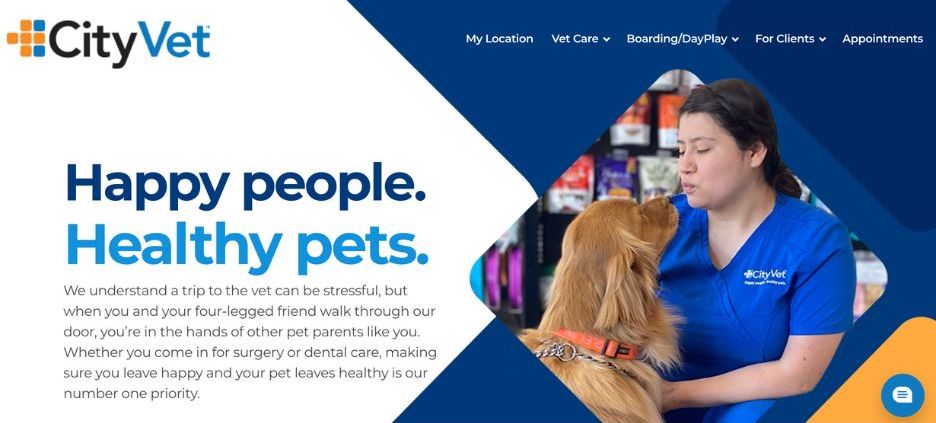
This vet is speaking directly to its target market on its website homepage.
But if your business serves a wider audience or a variety of products, you may have a harder time narrowing this down into a neat little bucket. For example, grocery stores provide groceries for all kinds of people.
It can help to look at what your customers have in common. Grocery shoppers need to buy groceries and they likely live close to your grocery store. That can be a good place to start when it comes to identifying your target market.
Once you outline what these customers might have in common, it’s time to look into some key differences that can help you further identify your target market.
This step may also require identifying different target markets for different product buckets. For example, you might have health-conscious shoppers who purchase organic produce and gluten-free freezer meals. This is a much different group than a large family who purchases budget-friendly ingredients in bulk.
Take some time to think through your different products and identify the customers who frequently purchase those products. There may be overlap, but it’s a good place to start!
2. Look at the data
Once you have some preliminary ideas about who your target market is, it’s time to back up those assumptions and hypotheses with data.
If you have access to customer data through a CRM, you can segment your customers by information like age, zip code, or products purchased. If you don’t have easy access to data about your customers, you can conduct a survey to collect information about your customers that can be used to narrow down your target market.
Make sure to go beyond the usual demographic data to find out information about how your customers spend their time, what their interests are, and where they spend time online.
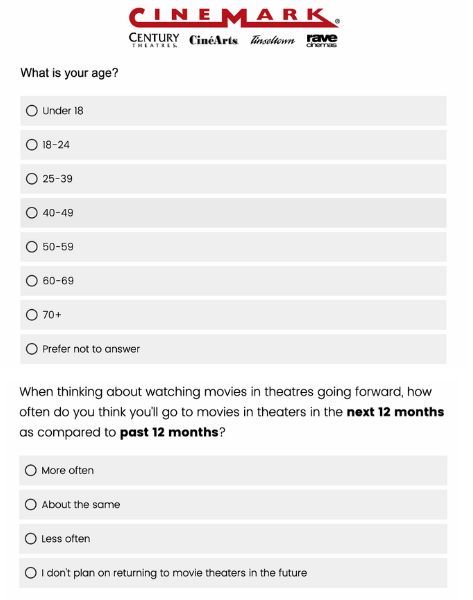
This survey example from Cinemark shows a mix of demographic and behavioral questions to help them better understand their target market.
This can help you further tailor and personalize your marketing strategy down the line.
3. Analyze the competition
The next step in finding your target market is to look at your competition and see who they’re targeting with their products and services.
List your top three competitors and look at their products and services. What needs are they trying to meet with them?
You can also look at their overall business like their branding, their locations, and their websites to see if you can pull out their unique value propositions as well as any clues as to who they’re targeting.
For example, if one of your top dental competitors has a giant jungle gym in their waiting room, it’s safe to say their target audience is parents and kids.
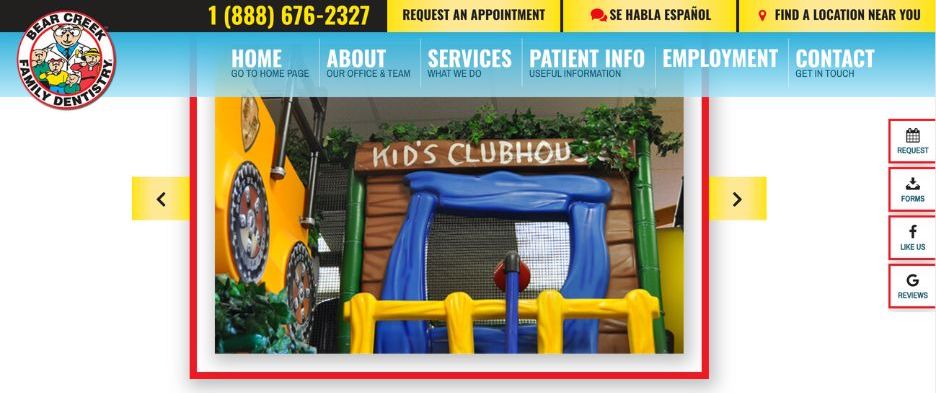
4. Look at target market examples
Why start from scratch when you can look at target market examples to help guide you in identifying the right fit for your business?
Target market examples can take some of the work out of it for you by outlining specific consumer groups, their interests, and how they spend their time—both online and offline.
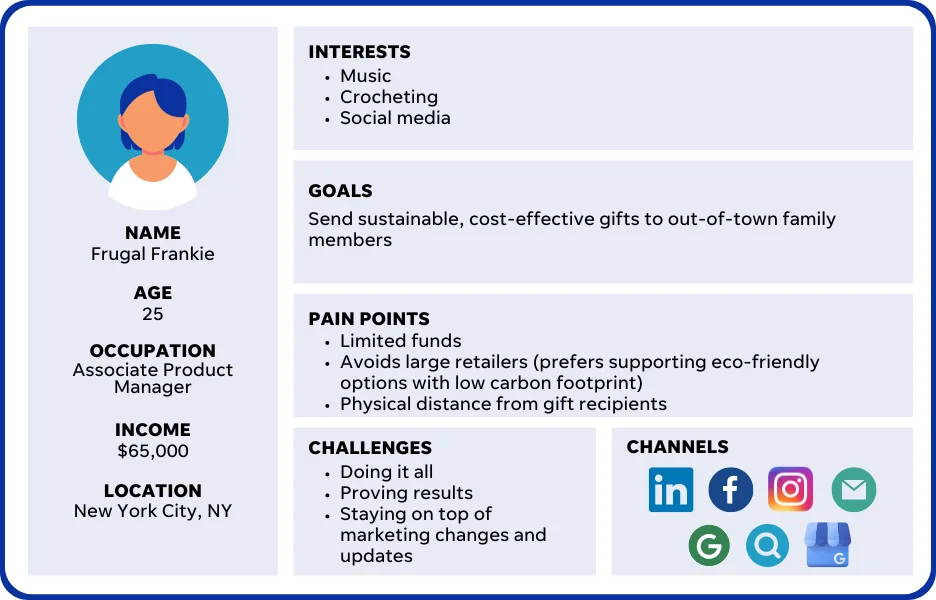
Lucky for you, we’re sharing six industry target market examples.
📚 Free guide: 37 Ways to Promote Your Business (With or Without Budget)
6 key target market examples
Here are six target market examples broken down by industry to help you narrow in on the best audience for your business to reach (plus how to reach them!).
Home services and home improvement
Here’s a target market example for businesses in the home services and home improvement industries such as plumbers, HVAC professionals, roofers, landscapers, home cleaning services, and more.
Key demographics
- Age range: 35-65
- 50% women, 50% men
- 86% are homeowners
- Median income of $108,000
What to know about them
- May be interested in home improvement or renovation shows on HGTV.
- May live in suburban areas.
- May spend time with family, taking kids to school or activities, and trying DIY home improvement projects on the weekends.
How to reach them
- Search advertising: 55% of homeowners conduct a search before scheduling an appointment with a home services business. (And for businesses like pest control, moving, and locksmiths, that number is over 70%!) So, you can reach these searchers with local PPC ads to convert them when they’re researching businesses like yours.
- Online reviews: We know that online reviews are a big factor homeowners look into during the buyer’s journey. So make sure you’re getting positive reviews for your business—and responding—to help influence these customers.
- Targeted email marketing: With targeted email marketing, you can send email campaigns promoting your businesses to people within a specific zip code so you know you’re targeting likely homeowners in your area.
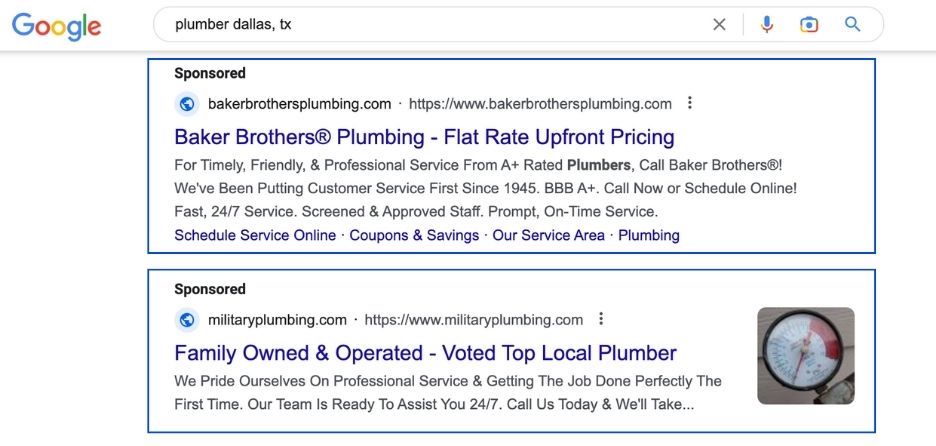
Education
Here’s a target market example for those marketing higher education institutions such as colleges and universities. The challenge these organizations and institutions may face is that they need to target both students and their parents.
Key demographics
- Students ages 15-18
- Parents and older students ages 35-54
- 53% women, 47% men
- Median household income for parents of $90,000
What to know about them
- Will either be in high school, have children in high school, or be looking to go back to school.
- Students spend a lot of time on social media and consuming media on YouTube.
- Building early brand awareness is key with this group as they typically have only two schools in mind before conducting any research and 75% end up enrolling at one of those two schools.
How to reach them
- Social ads: Prospective students spend time on social media sites and apps like Snapchat, TikTok, and Instagram. Reach them with targeted social ads that speak to the benefits of attending your school.
- YouTube ads: Per our study, YouTube ads have the highest ad recall of any channel and drive the most actions, so this is a great way to reach your education target market.
- Display ads: Start building awareness with both prospective students and their parents by running display ads across sites they frequent. This can help you become one of the two schools in students’ minds before they start their research.

Healthcare: Dentists
Depending on the specialty, healthcare businesses can target an extremely broad market. Everyone needs some type of healthcare services. Here’s a target market example for a dentist.
Key demographics
- Age range: 25-65
- 56% women, 44% men
- 54% have kids
- Median household income of $91,000
What to know about them
- Many people in this target market have kids and need dental care for both themselves and their children.
- Quality physicians and quality care are the two most important factors to people when choosing a dentist so include this information in your ads or marketing messages.
- Many people in this target market frequently use social media sites like Facebook or Instagram to look for reviews and find specials or coupons.
How to reach them
- Search advertising: Most people begin their search for new businesses, including dentists, on search engines. Plus we know search advertising is highly effective and engaging for dentists, with an average conversion rate of 11.73%, higher than the average conversion rate across industries of 7.26%.
- Targeted email marketing: Because most people won’t travel too far to go to the dentist, you can target specific zip codes with email marketing campaigns that provide coupons and testimonials to sway new patients.
- Direct mail: Send direct mailers to homeowners near your dental practice with a coupon or special to increase new patient appointments. Make sure to use specific coupon codes so you can track the effectiveness of your direct mail campaign.

SEO is also important for healthcare. Get healthcare SEO tips to capture new patients here.
Real estate
Real estate businesses are targeting those either buying or selling their homes in a specific area. Here’s a target market example that could work for many residential real estate agencies.
Key demographics
- Age range: 25-64, with a median age of 44
- 50% women, 50% men
- 60% are married
- Median household income of $109,000
What to know about them
- The majority currently own a home, which means you’re likely targeting those looking to both sell their current home and purchase a new home.
- May live in suburban areas.
- May enjoy dining out at nicer restaurants and shopping at department stores and high-end boutiques.
How to reach them
- Search advertising: Because most people begin their research with an online search, search advertising is a great way to get your business in front of potential clients. Real estate businesses are also eligible for Local Services Ads, which can help you convert searchers quicker.
- Social media advertising: Because this group is mostly comprised of millennials, you know that they spend a lot of time on social media. Targeting them with social media ads on Facebook and Instagram can help you reach them directly.
- Referral program: People trust recommendations from friends and family members, so setting up a referral program that rewards your existing clients when they refer you to new clients can help you grow your real estate business without a huge lift from your end.

Professional services: Legal
Depending on the type of law practiced, your target market will change, so it’s important to be familiar with your ideal customer. Here’s a target market example for general legal businesses.
Key demographics
- Age range: 18-34 and 55+ with a median age of 55
- 47% women, 53% men
- 59% are married
- Median household income of $102,400
What to know about them
- Most likely own a home.
- May enjoy watching sports on TV.
- Use the internet to track their investments and still read a newspaper.
How to reach them
- Display ads: As many in this target market example are a little older, you can target them on websites they might visit to engage with their interests, such as sports, travel, real estate, and more. A display ad on these sites can build awareness and drive people to learn more about you on your website.
- Targeted email marketing: With targeted email marketing, you can send email messages to people in specific areas or in specific demographics who may be in need of legal services.
- Search advertising: People in this target market example likely won’t venture past the first page of search engines, so they may be more likely to click on your search ad.

Retail: Furniture
Target markets for retail businesses will vary based on the type of goods your business sells. Here’s a target market example for furniture retailers.
Key demographics
- Age range: 35-64
- 56% women, 44% men
- 60% are married
- Median household income of $92,000
What to know about them
- Likely own their own homes.
- Likely interested in home improvement shows on TV—channels such as HGTV.
- Many of them likely have kids in the home.
How to reach them
- Social ads: This age range spends a lot of time on social media, so targeting them with beautifully-designed ads that show off your furniture can drive them to make a purchase.
- Display ads: You can showcase your furniture on websites people in this target market example frequent to build awareness and drive them to purchase your product or visit your showroom.
- YouTube ads: With YouTube ads, you can target users by life event, so you can target those who recently graduated, recently moved, or who recently got married.
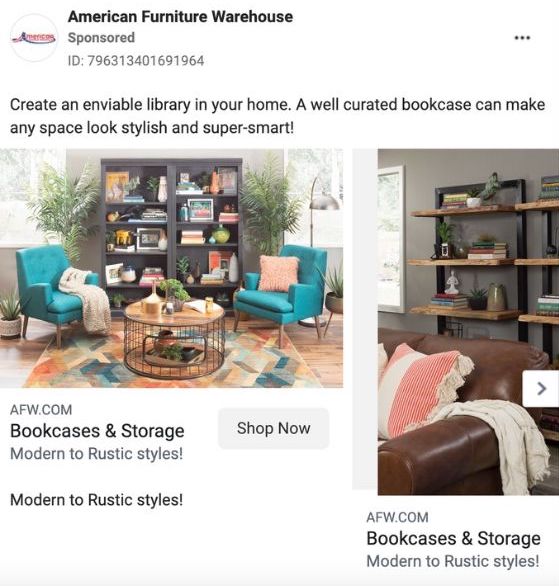
Travel
Here’s a target market example for businesses in the travel industry, such as a hotel, airline, or travel agent.
Key demographics
- Age range: 25-65+ with a median age of 50
- 50% women, 50% men
- 60% are married
- Average household income of $104,300
What to know about them
- Most are likely to own their homes.
- Likely enjoys eating out at restaurants with their families.
- Likely shops at high-end retailers and organic grocery stores.
How to reach them
- Social ads: People in this target market example spend a lot of time on social media—and many use social media to research their next vacation. Use social ads to target them.
- Search advertising: As people in this target market example search for accommodations or travel arrangements, use search ads to increase awareness for your business and drive them to your site.
- Email marketing: People in this group still value a good deal. Make sure to send emails about specials or promotions to entice vacationers to book quickly.

Use these target market examples to define your own
By understanding your target market, you can get to know your customers, where they spend time—both online and offline, and the best ways to reach them. You can also use it to write a strong positioning statement. Your business may need to get even more specific than these target market examples, in which case, it all comes down to tailoring your messaging and your marketing strategy to what’s going to work for you.
Need help finding your target market or want to put this info into action for your business? Reach out for a demo to learn more.






